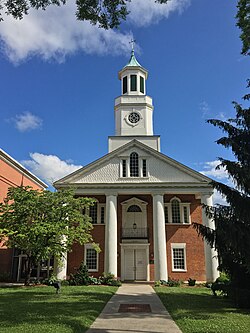Hawkins County, Tennessee | |
|---|---|
 The Hawkins County Courthouse in Rogersville, built c. 1836, is the oldest courthouse in Tennessee | |
 Location within the U.S. state of Tennessee | |
 Tennessee's location within the U.S. | |
| Coordinates: 36°26′N82°57′W / 36.44°N 82.95°W | |
| Country | |
| State | |
| Founded | 1787 [1] |
| Named after | Benjamin Hawkins [2] |
| Seat | Rogersville |
| Largest city | Church Hill |
| Area | |
• Total | 500 sq mi (1,300 km2) |
| • Land | 487 sq mi (1,260 km2) |
| • Water | 13 sq mi (34 km2) 2.5% |
| Population (2020) | |
• Total | 56,721 |
| • Density | 117/sq mi (45/km2) |
| Time zone | UTC−5 (Eastern) |
| • Summer (DST) | UTC−4 (EDT) |
| Congressional district | 1st |
| Website | www |
Hawkins County is a county located in the U.S. state of Tennessee. As of the 2020 census, the population was 56,721. [3] Its county seat is Rogersville. [4] Hawkins County is part of the Metropolitan Statistical Area, which is a component of the Johnson City-Kingsport-Bristol, TN-VA Combined Statistical Area, commonly known as the "Tri-Cities" region.
Contents
- History
- Law and government
- Executive Branch
- Legislative Branch
- Geography
- Adjacent counties
- State protected area
- Other protected area
- Other historic sites
- Demographics
- 2020 census
- 2010 census
- 2000 census
- Economy
- Transportation
- Major highways
- Airports
- Communities
- Cities
- Towns
- Census-designated place
- Unincorporated communities
- Politics
- Education
- In popular culture
- See also
- References
- External links








